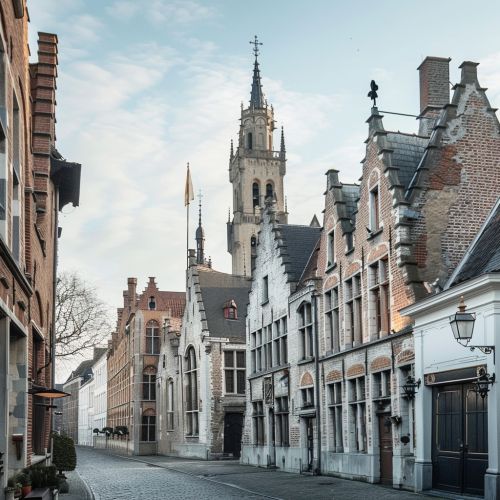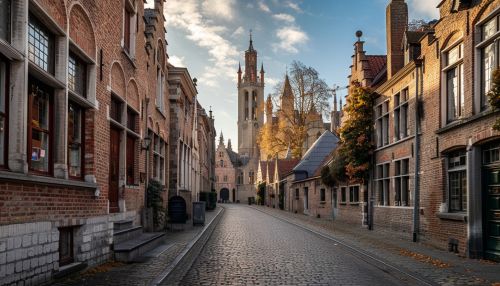Bruges
History
Bruges, known as Brugge in Dutch, is a city in the Flemish Region of Belgium. It has a rich history that dates back to the early Middle Ages. The city's name is derived from the Old Dutch word "brugga," meaning "bridge," indicative of its numerous canals and waterways.
Early History
The earliest traces of human activity in the Bruges area date back to the Pre-Roman Iron Age. However, the first significant settlement emerged during the Roman period, around the 1st century AD. This settlement was primarily a trading post, benefiting from its proximity to the North Sea and the Zwin estuary.
Medieval Period
Bruges experienced significant growth during the medieval period, particularly from the 9th to the 12th centuries. The city became an important commercial hub due to its strategic location and its access to the sea. By the 12th century, Bruges had developed into a prominent center for trade, especially in wool and cloth.
The city's golden age occurred during the 13th and 14th centuries when it became one of the most important trading cities in Europe. Bruges was a member of the Hanseatic League, a commercial and defensive confederation of merchant guilds and market towns in Northwestern and Central Europe. The city attracted merchants from all over Europe, including Italy, Spain, and the Baltic region.
Decline and Revival
The 15th century marked the beginning of a decline for Bruges. The Zwin estuary, which had been crucial for the city's trade, began to silt up, making navigation increasingly difficult. Additionally, political and economic shifts in Europe led to a decline in Bruges' commercial importance.
However, the city experienced a revival in the 19th century, driven by the burgeoning tourism industry. The preservation of its medieval architecture and the romantic appeal of its canals attracted visitors from around the world.
Geography
Bruges is located in the northwest of Belgium, in the province of West Flanders. The city covers an area of approximately 138.4 square kilometers and has a population of around 118,000 inhabitants.
Topography
The topography of Bruges is relatively flat, with an average elevation of about 2 meters above sea level. The city is characterized by its extensive network of canals, which have earned it the nickname "Venice of the North."
Climate
Bruges has an oceanic climate, classified under the Köppen climate classification as Cfb. The city experiences mild winters and cool summers, with an average annual temperature of around 10°C. Precipitation is relatively evenly distributed throughout the year.
Architecture
Bruges is renowned for its well-preserved medieval architecture. The city's historic center, a UNESCO World Heritage site, is a testament to its rich architectural heritage.
Gothic Architecture
One of the most striking features of Bruges' architecture is its Gothic buildings. The Church of Our Lady is a prime example, with its towering spire reaching 115.5 meters, making it one of the tallest brick buildings in the world. Another notable Gothic structure is the Belfry of Bruges, a medieval bell tower that stands 83 meters tall and offers panoramic views of the city.


Romanesque and Renaissance Architecture
In addition to Gothic architecture, Bruges also boasts significant Romanesque and Renaissance buildings. The Basilica of the Holy Blood is a notable Romanesque structure, famous for housing a relic believed to contain the blood of Jesus Christ. The Stadhuis (City Hall), built in the late 14th century, is an excellent example of Renaissance architecture, featuring ornate facades and intricate sculptures.
Economy
Bruges has a diverse economy, with key sectors including tourism, manufacturing, and services.
Tourism
Tourism is a major economic driver for Bruges. The city's historic charm, combined with its cultural and architectural heritage, attracts millions of visitors annually. Key tourist attractions include the Groeningemuseum, which houses an extensive collection of Flemish and Belgian art, and the Bruges Beer Museum, which offers insights into the city's brewing history.
Manufacturing
Bruges also has a significant manufacturing sector, particularly in the areas of textiles, food processing, and machinery. The Port of Zeebrugge, located nearby, is one of the largest ports in Europe and plays a crucial role in the city's economy, facilitating trade and logistics.
Services
The services sector in Bruges is well-developed, with a strong emphasis on finance, education, and healthcare. The city is home to several higher education institutions, including the College of Europe, a prestigious postgraduate institute specializing in European studies.
Culture
Bruges has a vibrant cultural scene, with numerous festivals, museums, and cultural institutions.
Festivals
The city hosts several annual festivals, including the Bruges Triennial, an international contemporary art exhibition, and the Bruges Beer Festival, which celebrates the city's rich brewing tradition. The Procession of the Holy Blood, held annually on Ascension Day, is a significant religious event that attracts thousands of participants and spectators.
Museums
Bruges is home to a wide array of museums, catering to diverse interests. The Groeningemuseum features a comprehensive collection of Flemish and Belgian art, while the Historium Brugge offers an immersive experience of the city's medieval history. The Frietmuseum is dedicated to the history and culture of Belgian fries, a beloved national dish.
Education
Bruges has a well-developed education system, with several institutions offering primary, secondary, and higher education.
Primary and Secondary Education
The city has numerous primary and secondary schools, both public and private. These schools offer a range of educational programs, including general, technical, and vocational education.
Higher Education
Bruges is home to several higher education institutions, including the College of Europe, which is renowned for its postgraduate programs in European studies. The Howest University of Applied Sciences offers a variety of undergraduate and postgraduate programs in fields such as technology, business, and design.
Transportation
Bruges has a well-developed transportation infrastructure, facilitating easy access to and within the city.
Public Transportation
The city is served by an extensive public transportation network, including buses and trains. The Bruges railway station is a major hub, offering connections to other Belgian cities and international destinations.
Cycling
Cycling is a popular mode of transportation in Bruges, thanks to the city's flat terrain and extensive network of bike paths. The city promotes cycling as a sustainable and healthy alternative to motorized transport.
Road and Waterways
Bruges is well-connected by road, with several major highways providing access to the city. The city's canals also play a crucial role in transportation, particularly for tourism and leisure activities.
See Also
- Hanseatic League
- Tourism
- Church of Our Lady, Bruges
- Belfry of Bruges
- Groeningemuseum
- Bruges Beer Museum
- Port of Zeebrugge
- College of Europe
- Bruges Triennial
- Procession of the Holy Blood
- Historium Brugge
- Frietmuseum
- Howest University of Applied Sciences
- Bruges railway station
